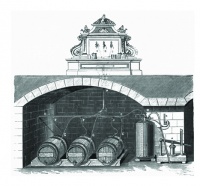After a hard day’s work building Britain’s mighty infrastructure, I’m sure Victorian engineers craved nothing more than a nice glass of cold beer. Indeed, The Engineer’s archives of 1882 reported on a ’beer engine’ that delivers the amber nectar to the taps of any bar more efficiently and at a lower temperature ’to preserve taste’.

It was the invention of one MPF Gougy of Paris ’by which the counter or bar pumps are made unnecessary’ through an ’arrangement of apparatus not known much in this country’.
The article described the equipment illustrated in the engraving above: ’The pressure in the accumulator [B] being sometimes five times more than necessary to make the beer flow from the cellar, provides a large reserve of air and thus allows the attendant to draw a large quantity of beer without being obliged to work the pump. In most cases air is pumped in the accumulator in quantities sufficient for a day.
“It passes through a large pipe in lead that contains ice to cool the beer as it loses much of its flavour if warm”
’[Pipe G] is connected to pewter pipes that pass through a large pipe in lead containing ice to cool the beer, as generally the cellars are not cool enough as the beer loses much of its good flavour if warm.’
Well you wouldn’t want a warm beer would you?
Perhaps most controversially, the article suggested that ’carbonic acid may be passed into the casks instead of air at a vent peg, thus keeping up the flavour of the beer or other liquor’.
This might well represent the foundation of today’s gaseous continental lagers, hugely popular of course, but derided by the ’real-ale brigade’.
Indeed we also get a hint of modern brewing gimmicks such as ’extra cold’ taps seen in some bars: ’Recently M Gougy has made some alterations… the refrigerator has been modified to allow one to alter the coolness of the beer by simply turning the key of the tap right or left.’




Glasgow trial explores AR cues for autonomous road safety
They've ploughed into a few vulnerable road users in the past. Making that less likely will make it spectacularly easy to stop the traffic for...